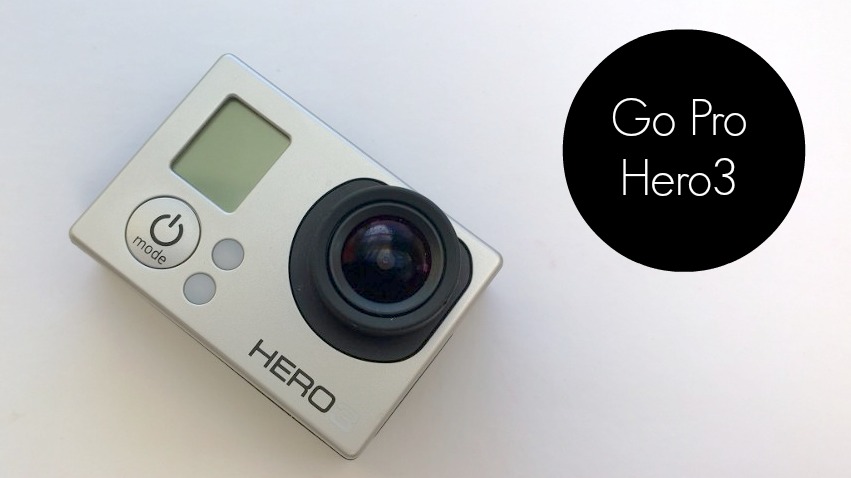So, one of the nice things about being a blogger and a former tech journalist is that people periodically sent you new bits of kit to try out.
In recent weeks, we’ve tried a fair few new devices and I thought I’d select two cameras to review this week – the GoPro Hero3 camera, and the Panasonic X-100 head-mounted camera.
Wearable cameras are increasingly popular among sporty types but also families who want to capture memories without having to hold up an actual camera – so how do these two devices compare?
Go Pro Hero3 Camera
This is another toy we were sent along with something else – we recently reviewed the Nissan Note and were given a GoPro Hero3 camera to capture some footage.
I’d never seen a GoPro before but friends who ski and surf have raved about them, and I can see why – at a smidge over £250 for the camera plus a waterproof casing, these little beauties are only a little bigger than a matchbox, but can capture professional quality video up to 1080p and 5MP still images at 3 per second. There’s built-in WiFi and a downloadable app which means you can mount your camera somewhere, and then view the footage, and control the camera via an app on your smart phone.
Pretty cool, eh?
What we especially love is that you can get all kids of mounts and cases for your GoPro, so you can use it virtually anywhere. There are straps and mounts to use on the side or top of helmets, suction bases that can be attached to your car, a water-proof base to fix the camera to a surf board, and a range of chest and wrist mounts in kid and adult sizes. Whatever you want to get up to, your GoPro will be able to go with you.
Here’s some footage we shot on the GoPro, earlier this week at Chill Factore:
The camera looks very basic with just a few buttons – one to turn on and off and one to record, along with a single button that allows you to scroll through various options around deleting, saving and so on. The camera charges via a USB cable and we found it would easily run for a day (although you need to turn WiFi off as much as possible, it’s very power hungry).
The footage is generally as good as anything we’ve taken on a bigger device, and my only possible downside is now wanting to buy ALL the accessories – there’s a great looking LCD add-on, and I’ve got my eye on the diving case for our trip to Mauritius in a few weeks’ time.
Panasonic HX-A100 Wearable Camera
Like the GoPro, the Panasonic HX-A100 is a wearable camera that captures HD footage from your point of view. This one has an RRP of £299, but I have seen it on sale for well under £200 at various sites online.
Compared to the GoPro, this device is larger, including a small, bullet-shaped camera that can be fixed to an included over-ear-headband contraption (not a technical term) and then a cable connecting it to a battery pack, that sits on your pocket or on your belt.
Splitting the device into two has the immediate advantage of creating a smaller camera on your head, and the eye-level perspective is BRILLIANT and surprisingly, especially if you want to capture point-of-view footage, whether it’s biking, or doing craft demonstrations. With in-built WiFi you can also stream content as you film it, although we didn’t try out this feature. The Panasonic does work under water but only up to a depth of 5 feet, making this an option for swimming pool holiday footage, rather than diving, I guess.
To use the camera’s full functionality, you really need to download a smartphone app, which then connects your phone to the camera’s own WiFi network, and gives you access to full controls (some basic controls are on the battery pack). From there you can film a good 3 or 4 hours of footage, and the removable SDHD card means you’re not worried about running out of space.
A couple of small niggles, though.
Flea couldn’t use the included head mount – it was just entirely the wrong shape for a child’s head and couldn’t really be adjusted, which meant her plan to capture her thrilling assault on the local BMX course had to be abandoned (although to be fair, you can buy helmet mounts for the HX-A100 if you want them).
Personally I found it uncomfortable and insecure, and I couldn’t work out whether I looked more like Data from Star Trek or one of those guys from the “White Guys Wearing Google Glass” Tumblr when I was wearing the camera. Neither of these are a look I aspire to, incidentally. The addition of a thick, fixed cable from camera to battery pack felt just weird and old-fashioned, and even though I’m not especially tall, having the battery pack in my pocket meant the cable tugged on my ear as I used the camera.
Also, I’m not sure why, but the HX-A100 seems to give a bit of a fish-eye effect. Here’s a short clip (of me making breakfast, thrill fans!) shot on the Panasonic:
The initial set-up and use also seemed more fiddly than I’d expected. Getting everything connected and working took a few hours. In use, the camera was a lot more noticeable than the GoPro because of the fixed cable – although that really is a small niggle, because I liked how robust it felt, in general, and having a separate battery means the camera on the side of your head is a bit smaller.
The Verdict
So how does the footage compare? Honestly, they’re about equal. I found the sound was superior on the Hero3 unless there was any kind of casing on the camera in which case the sound was utterly rubbish and barely worth bothering with. But the Panasonic has the “fish eye” issue, that I’m really not keen on.
Both provided decent footage for web use – although it should be noted that footage shot on the Nokia Lumia 1020 I was gifted by Microsoft last year is generally brighter and crisper than both of these wearable cameras – although the sound lets it down a little. The camera on the Lumia out-performs most of my devices and I’m only just beginning to use it for video, but it’s ridiculously easy to produce something really usable for blog purposes.
So here’s what I reckon:
If you truly need a camera that’s hands-free, then go for the Panasonic HX-A100. It’s a solid, great quality camera, especially outdoors. The footage tends to be a little steadier, and the perspective of a head-level camera is great.
If you need something that can be used in lots of different ways – on a helmet, on your chest, on a car or bike – then go for the GoPro, on the basis of the accessories available and general portability. I like that Flea can easily operate the GoPro, and with the casing on, it feels really robust and can be dropped without too much fear.







I was planning to buy a Wearable camera for our outdoor travel trips so thanks for comparing these two devices here as your article will help me to choose one that can fit into our need and budget.